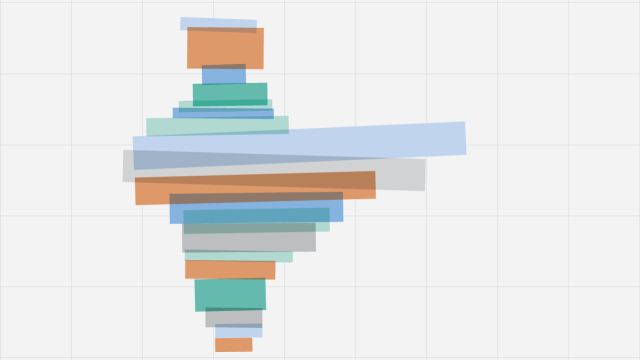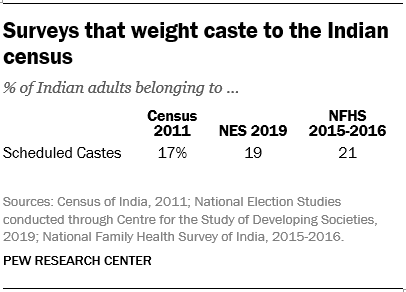
India’s caste system is an ancient social hierarchy based on occupation and economic status, with roots in historical Hindu writings. People in India are born into a particular caste and tend to keep many aspects of their social life within its boundaries, including whom they marry and whom they choose to count as their close friends.
Despite the caste system’s significance in Indian society, there is no consensus on exactly what proportion of Indians belong to each caste category. One commonly cited source for this information is the nation’s 2011 census, but its methods for determining caste have been criticized for anomalies and errors. Surveys have also tried to measure caste in India, but they tend to use a different methodology and generally produce different estimates from those produced by the census.
This post explains why caste distribution in India is consequential to policymaking and politics. It also explores the methodological differences between the country’s census and national surveys — including a new Pew Research Center survey — when it comes to measuring caste in India.
Background
Most Indians say they belong to a lower caste category — specifically, Scheduled Caste (SC), Scheduled Tribe (ST) or Other Backward Class (OBC), according to the Center’s new survey, which was fielded in 17 languages among nearly 30,000 Indian adults between Nov. 17, 2019, and March 23, 2020.
Notably, even though not all religions in India theologically recognize a caste system, nearly all Indians (98%) identify as a member of a caste, regardless of their religious background. For example, 33% of Christians in India identify as SC, even though Christianity does not traditionally have a caste system.

Members of India’s lower castes historically have formed the lower social and economic rungs of society and have faced discrimination and unequal economic opportunities. The Indian Constitution bans “untouchability,” a practice that has been used to ostracize members of SC (often referred to as Dalits). And there have been government policies put in place to provide economic support for members of historically disadvantaged castes. Today, this includes an affirmative action system that reserves spots at universities and some portion of government jobs for members of Scheduled Castes, Scheduled Tribes and Other Backward Classes. The size and scope of many of these programs, known collectively as “reservation,” is politically controversial.
While there may be a social stigma associated with identifying as a member of a lower caste, there may also be incentives associated with doing so. To the extent that there are biases associated with identifying as lower caste in the census or a survey, the direction of the bias remains unclear.
Caste in India’s 2011 census
In India’s 2011 census, only Hindus, Sikhs and Buddhists — who form over 80% of the nation’s population, according to the census — could be classified as Scheduled Castes. Muslims, Christians and members of other religions may have been excluded because these religions, at least in principle, do not have a caste system. However, members of all religions could be classified as Scheduled Tribes, as tribal communities often have many different religious backgrounds.

India’s 2011 census enumerators made an effort to independently verify whether respondents were correctly classifying themselves as Scheduled Caste or Scheduled Tribe. This was no easy feat: Indians who said they were part of a Scheduled Caste or Tribe were then asked to name which caste or tribe they were from. Enumerators had to match the group name to a pre-approved list of more than 1,000 castes and tribes that differed by state. If a respondent identified as a member of a Scheduled Caste or Tribe, but the name they gave was not on the list, they were not counted as SC or ST in the census.
Using this methodology, the 2011 census reported 17% of Indians as members of Scheduled Castes and 9% as members of Scheduled Tribes.
OBC, an additional lower caste category with yet another set of parameters than SC and ST, was not measured as part of the 2011 census. This category came to the forefront in 1990 when the government of then-Prime Minister V.P. Singh tried to implement an additional 27% reservation for members of OBC in the country’s government jobs, with the reasoning that there were other socioeconomically disadvantaged people in India besides SC or ST. The decision to implement the quota was based on an earlier report by the government-appointed Mandal Commission on social backwardness in India. With additional reservation for OBC communities, the total caste-based reservation would increase considerably to about 50% or higher in some states. The government’s decision to implement the reservation policies was widely seen as a political ploy and led to protests around the country, including a series of self-immolations by university students.
Despite the high political salience of the OBC category, no official estimates of the group are currently available. The Mandal Commission was heavily criticized for basing its recommendations on a pre-independence census. A second census fielded in 2011 focused on caste with the aim of obtaining more accurate numbers on lower castes in India, including OBCs, but this data has not been released due to data quality concerns.
Survey estimates
Pew Research Center’s new survey about religion in India asked about caste in a different way than the 2011 Indian census. All respondents, regardless of religion, were asked this question: Are you from a General Category, Scheduled Caste, Scheduled Tribe or Other Backward Class? (Note: General Category includes castes and sub-castes that don’t fall into a lower caste category.)

Using this methodology, 25% of Indians self-identify as Scheduled Caste and 9% say they are from a Scheduled Tribe. The SC estimate is considerably higher than the 2011 census estimate of 17%, although the ST estimate is identical (9%). An additional 35% of Indians identify as OBC in the Center’s survey.
The difference between the census and the survey estimate of SC may in part be a result of who was asked the question. The Center’s survey asked everyone, while the census asked only Hindus, Sikhs and Buddhists. Also, the survey asked people to self-identify into these categories and did not include a checking procedure as the 2011 census did.
In the Center’s survey, the Hindu caste distribution generally resembles that of the total population, but minority groups differ widely in their caste composition. For example, a large majority of Buddhists (89%) identify as SC, but just 3% of Jains fall into this category. Among Muslims, a small share (4%) identify as SC, but many (43%) identify as OBC.
How do these caste estimates compare with those produced by other national, probability-based surveys in India? Survey results differ based on several factors, including sampling, weighting methodology and question wording. But even when taking these differences into account, surveys often report a higher share of Scheduled Caste members than the 2011 census. For instance, the India Human Development Survey and previous Pew Research Center surveys report caste distributions that are generally aligned with the results of the latest Center survey.
These surveys differ in question wording, but they ask all respondents their caste, and they do not independently verify caste names. Further, these surveys do not use caste in the sampling design — either in how they distribute the interviews nationally or in how they weight the data.
Surveys that incorporate caste in the sampling design
Another comparison point is the National Family Health Survey (NFHS). NFHS is one of the largest government surveys in India, and it is considered a national benchmark for several measures. In a survey conducted in 2015–2016, NFHS asked all respondents their caste. But according to the survey’s documentation, NFHS used the 2011 census caste distributions in its stratification at the sample design stage. This means that the compiled list of all Census Enumeration Blocks in urban areas and villages in rural areas were divided into subgroups based on the percentage of the population belonging to Scheduled Castes and Scheduled Tribes as determined by the census data.

This design decision increased the likelihood that the caste distribution of those sampled would be similar to what the census reported as the national caste distribution. Even with these design choices, the 2015–2016 NFHS reported a higher share of Scheduled Castes than the census — 21% vs. 17%. (For reference, Pew Research Center’s latest survey study finds 25% of Indians belonging to Scheduled Castes.)
The National Election Studies (NES), performed by the Centre for the Study of Developing Societies, are some of the largest pre- and post-election public polls in India, and they weight to the national census for caste. This strategy aligns the survey’s caste estimates to approximately those of the census.
Whether or not researchers decide to stratify or weight a survey to census caste numbers can depend on the goals of the survey. With surveys that aim to report on issues such as voting behavior or socioeconomic status, like the NFHS or the NES, including caste in the design could better meet the survey’s goals. However, because these surveys include caste in the design of the study, their caste estimates can be closer to those of the census and not directly comparable with Pew Research Center surveys or other surveys that do not include caste in the design.
Caste remains a complicated and integral aspect of life in India, as well as a political flashpoint. Measuring caste in India is highly consequential for understanding social dynamics in Indian society as well as for policymaking. But so far there is no consensus on how to measure caste identity in India, or even who should be asked the question (all Indians or members of particular religious groups). These differences in methodology can result in national sample surveys yielding different estimates than the 2011 Indian census.